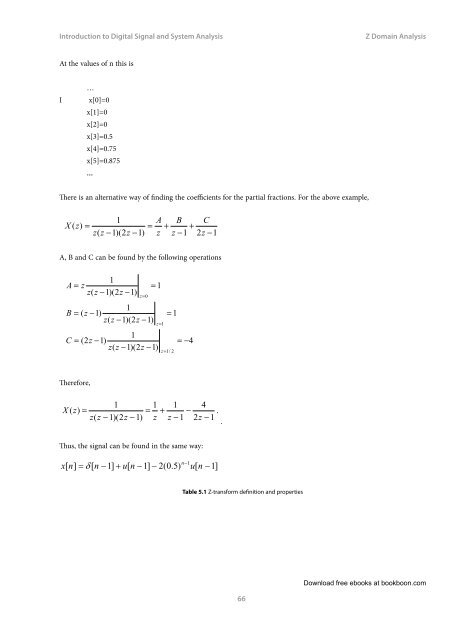Introduction to Digital Signal and System Analysis - Tutorsindia
Introduction to Digital Signal and System Analysis - Tutorsindia
Introduction to Digital Signal and System Analysis - Tutorsindia
Create successful ePaper yourself
Turn your PDF publications into a flip-book with our unique Google optimized e-Paper software.
<strong>Introduction</strong> <strong>to</strong> <strong>Digital</strong> <strong>Signal</strong> <strong>and</strong> <strong>System</strong> <strong>Analysis</strong><br />
Z Domain <strong>Analysis</strong><br />
At the values of n this is<br />
I<br />
…<br />
x[0]=0<br />
x[1]=0<br />
x[2]=0<br />
x[3]=0.5<br />
x[4]=0.75<br />
x[5]=0.875<br />
...<br />
There is an alternative way of finding the coefficients for the partial fractions. For the above example,<br />
X ( z)<br />
=<br />
1<br />
=<br />
z(<br />
z −1)(2<br />
z −1)<br />
A<br />
z<br />
+<br />
B C<br />
+<br />
z −1<br />
2z<br />
−1<br />
A, B <strong>and</strong> C can be found by the following operations<br />
1<br />
A = z<br />
z(<br />
z −1)(2<br />
z −1)<br />
z=<br />
0<br />
1<br />
B = ( z −1)<br />
z(<br />
z −1)(2<br />
z −1)<br />
= 1<br />
1<br />
C = (2z<br />
−1)<br />
z(<br />
z −1)(2<br />
z −1)<br />
z=<br />
1<br />
= 1<br />
= −4<br />
z=<br />
1/ 2<br />
Therefore,<br />
1 1 1 4<br />
X ( z)<br />
=<br />
= + − .<br />
z(<br />
z − 1)(2 z − 1) z z − 1 2z<br />
− 1<br />
.<br />
Thus, the signal can be found in the same way:<br />
x[<br />
n]<br />
= d [ n −1]<br />
+ u[<br />
n −1]<br />
− 2(0.5)<br />
n−1<br />
u[<br />
n −1]<br />
Table 5.1 Z-transform definition <strong>and</strong> properties<br />
66<br />
Download free ebooks at bookboon.com
















